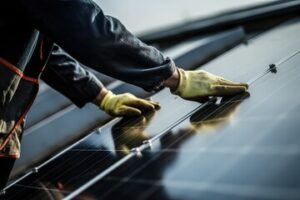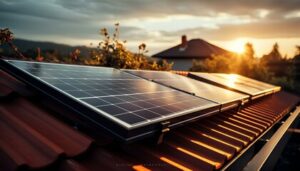Solar energy is popular right now because it helps homeowners save money on their electricity bills. Some even get extra income by selling their excess power back to the grid.

But it’s important to understand the technology behind these panels before you invest in one. Visit Website to learn more.
The basic function of a solar panel is to convert luminous energy into electric energy. This is achieved through photovoltaic cells, which are made from a combination of type n and type p semiconductor materials. When light hits these semiconductors, it knocks electrons loose from their atoms, creating two free charges in the process. When these charges are connected to a conductor and to an inverter, the direct current generated becomes alternating current, and the power output is measured in watts or kilowatts.
There are many factors that contribute to how much energy a solar system produces. The most important factor is how much sunlight it receives. The ideal condition for producing solar energy is clear, sunny weather. A shaded or cloudy day will still produce some energy, but at a lower rate.
To increase energy production, a series of panels can be wired together. This is called stringing and requires a solar charge controller and an inverter to convert the direct current into alternating current. The inverter can also be used to control the system.
The two main types of solar panel are monocrystalline and polycrystalline silicon. There is a lot of debate over which one is better, but they both work well in most applications. A third option is a thin film solar panel. These use a different manufacturing process and are very thin, almost paper-thin. Thin film solar systems have a lower efficiency than either mono or poly, but they are very durable and can be installed on non-traditional surfaces.
To get the most out of your solar system, it is essential to consider how much energy you use each day. You can use a solar sizing tool to calculate your energy needs and find the right size system for you. To protect your solar investment, you will need a battery backup system to provide power during the night and on cloudy days, and a solar grid tie inverter if you want to take advantage of the “feed-in tariff” offered by some utility companies.
Materials
There are several materials that make up a solar panel. First is silicon which makes up the majority of a PV cell. Silicon is the second most abundant element on earth and is readily available. The raw material is melted down and mixed with supportive elements in order to make sheets of silicon which then become the component cells that make up the PV system. There are a few different kinds of silicon solar cells; mono, poly and thin-film. Each has its own unique manufacturing process.
Mono-crystalline solar cells are made from a single crystalline silicon and have a more distinct appearance than other types of solar panels. They also have higher efficiency levels. Poly-crystalline solar cells are made from multiple silicon crystals that have been cut into wafers and are less expensive than mono-crystalline cells. Thin-film solar cells contain thin layers of semiconductor material such as cadmium telluride (CdTe) or copper indium gallium diselenide (CIGS), which are layered together and then affixed to a substrate. Thin-film solar cells have lower power outputs than their crystalline counterparts.
Once the cells have been fabricated they are assembled into modules which are then connected to form an array. This can be done either in parallel or in series to achieve the desired voltage capabilities of the PV system. If a panel is shaded, bypass diodes can be used to allow current to flow around the shaded area and increase the efficiency of the PV system.
The modules are then given a backsheet which protects the solar cells from the elements and any critters that may try to nibble on them. The sheet is also a good electrical insulator. Finally, terminal strips are placed which connect to the bus wires of the module. These are then soldered to the outgoing bus wires and the module is complete.
Efficiency
The efficiency of a solar panel depends on the materials used in production, its position on your roof, and how it is maintained. A solar panel should be kept free of dust to prevent a build-up that can interfere with sunlight absorption, so regular cleaning is necessary. The positioning of the solar panels is also important; they should be positioned so that they can absorb maximum sun exposure throughout the day.
Solar panel energy output is measured in watts or kilowatt-hours. The more efficient a solar panel is, the more power it will produce. This is why sizing your solar panel system is so important; a bigger system can generate more power but may not be feasible given the amount of space you have available.
The maximum solar panel efficiency is calculated as the ratio of cell power to sunlight power and expressed as a percentage. Cell efficiency should not be confused with panel efficiency, which includes internal gaps and frame structure in the calculation and reflects a lower figure due to these factors.
There are a few manufacturers of high-efficiency standard-size solar panels. LONGi Solar was the first manufacturer to reach 22% efficiency with its Hi-Mo 6 Scientists series, using a hybrid IBC cell design, and REC and Huasun Solar have recently announced next-generation HJT cells that achieve this level.
Polycrystalline solar panels, which are more common in the market, are typically less efficient than monocrystalline. This is because the silicon in a polycrystalline panel is not grown as a single crystal and instead as blocks of different sizes that are then cut into wafers to create the individual solar cells. Currently, polycrystalline solar panels have an efficiency of 15-22%.
Design
The solar panel contains photovoltaic cells that transform luminous energy into electric current. This happens when photons (light particles) reach a type n and type p semiconductor material in the solar panel. When photons hit the semiconductor, it causes two free electrons to be liberated, creating a difference of voltage that creates electric current.
Various solar panel technologies exist, but all use a similar basic concept. The main types of PV solar panels are monocrystalline, polycrystalline, and bifacial. Each of these types has its advantages and disadvantages, but each also offers a unique set of benefits.
A solar panel’s design can be affected by factors such as the module’s size, its solar rating, and the type of mounting system used. The panel’s location and orientation are also important.
Another consideration is the impact of shade, which can drastically reduce a solar panel’s output and lifespan. Fortunately, shade mitigation is becoming easier and more effective. This is thanks to advancements in technology, such as bifacial solar panels and solar roof tiles that hide the solar cells behind a decorative surface.
Solar design software solutions can help reduce the number of labor hours needed to complete a project and increase a company’s productivity. These tools typically include an ever-expanding database of modules, inverters, and racking systems. They also allow users to model and analyze the performance of their solar projects.
It is vital that a solar installer has access to good solar design software in order to avoid potential mistakes that can result in a system underperforming or failing. For example, if the array’s voltage exceeds the maximum input of an inverter, the system will underproduce. Inverter clipping can be prevented by using module-level power electronics, such as microinverters and DC optimizers.
Installation
Unless your customers have extensive electrical knowledge, the panel installation process should be left to the experts. Scaffolding should be put in place to provide support for workers and allow them to perform the work safely. Scaffoldings can also help ensure that safety measures are taken during the process and that workers adhere to all local ordinances.
After the paperwork has been filed and permits secured, it is time to get started with the actual installation. The first step is to gather all of the required equipment. This includes solar panels, charge controllers, inverters and batteries. Inverters convert the direct current generated by solar panels into alternating current, which can be used to power household appliances. There are many different types of inverters on the market, and each type has its own benefits and drawbacks. The most common type is called a string inverter and is capable of handling up to a certain number of panels.
Next, the panels are mounted on the mounting structure. Depending on the installation type, there are several different ways that panels can be mounted. For roof-mounted systems, it is important to properly angle the panels to maximise their efficiency. This can be done manually or with a tracker. For ground-mounted systems, it is important to find an area with no shade and a clear view of the sky.
After the panels are in place, they will be wired to a breaker box and meter. This meter will allow the homeowner to track their energy consumption and production. It will also allow them to sell their surplus energy back to the grid. In addition, a rapid shutdown switch will be installed in an easy-to-access location so that the system can be shut down in the event of a fire on the roof.
